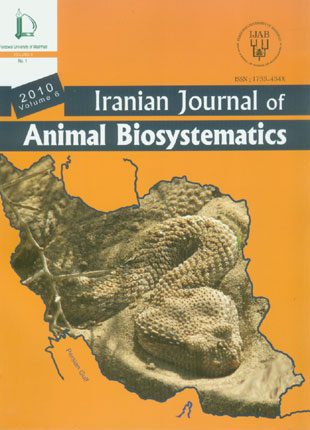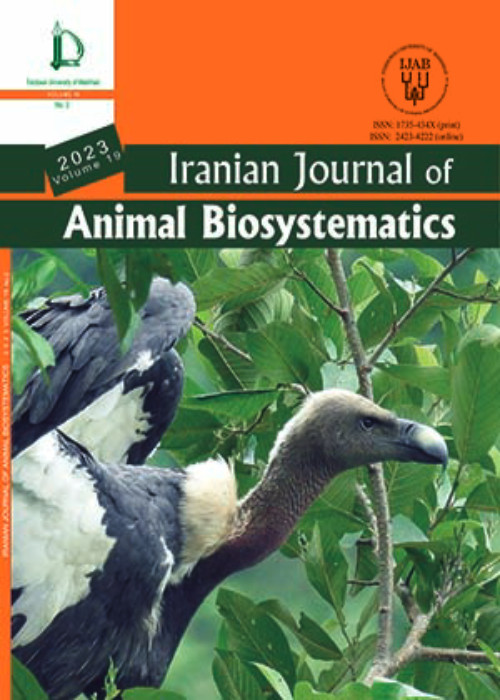فهرست مطالب

Iranian journal of animal biosystematics
Volume:6 Issue: 1, Winter-Spring 2010
- تاریخ انتشار: 1390/06/01
- تعداد عناوین: 6
-
-
Page 1This study was conducted to determine taxonomic and zoogeographic features of fishesfrom the Kor and Helleh River basins in southwestern Iran. The specimens werecollected from 2004 to 2007. Twenty four species belonging to 20 genera, 9 families, and6 orders from the Kor River basin and 21 species belonging to 19 genera, 8 families, and6 orders from Helleh basin were identified. Ichthyofauna of Helleh basin included somespecies not present in the Kor basin: Luciobarus barbulus, Tor grypus, Carasobarbus luteus,Garra rufa, Mastacembelus mastacembelus, Glyptothorax silviae, and Cyprinion cf. macrostomum.The Helleh basin ichthyofauna is a combination of western (Ethiopian) and eastern(Oriental) fauna. The cyprinid genera, Barbus, Alburnus, Capoeta, and Chondrostoma should be revised using both molecular and morphological data.
-
Pages 9-23Ilam Province in southwest Iran possesses varied climatic and geographical conditionsleading to rich biodiversity. An investigating of the status of snakes in the province wascarried out from June 2005 to March 2010. A total of 103 specimens were collected andidentified. Six families, 20 genera, and 26 species are represented, including Boidae: Eryx(Eryx) jaculus turcicus; Colubridae: Coluber andreanus, Dolichophis jugularis, Eirenis collaris,Eirenis punctatolineatus, Hemorrhois nummifer, Hemorrhois ravergieri, Malpolon insignitus, Malpolonmoilensis, Natrix tessellata, Platyceps najadum, Platyceps rhodorachis, Psammophis schokari,Pseudocyclophis Persicus, Spalerosophis diadema, Spalerosophis microlepis, Telescopus tessellatus;Elapidae: Walterinnesia morgani; Leptotyphlopidae: Myriopholis macrorhyncha; Viperidae:Cerastes gasperettii, Macrovipera lebetina, Pseudocerastes persicus, Pseudocerastes urarachnoides; andTyphlopidae: Typhlops vermicularis. With respect to the data which provided by Latifi(2000), more than 77% of the snakes are reported for the first time in this region. TheColubridae showed the highest species diversity among the families represented, with 16species.
-
Pages 25-35
Forty-nine preserved specimens (31 male and 18 female) of Trachylepis aurata transcaucsasicawere examined with respect to metric and meristic features and dry skull anatomy toassess sexual dimorphism. Thirty-one morphological characters and 36 anatomicalcharacters in dry skulls were examined. Subdigital lamellae under the forth toe, necklength, neck length/snout vent length, and six skull characters (skull length, condylobasallength, anterior rostrum width, eye width, and ratios of maxilla length to skull length andpterygoid length to skull length) were significantly different in males and females (P <0.05). Other observed differences were in the base of the tail, which was thicker in malesthan in females, and in the structure of the anus. The sexes did not show dimorphism incolor or pattern.
-
Pages 37-48Golestan province is located in northeastern Iran, southeast of the Caspian Sea, a regionthought to be one of the most important refuge areas during glacial periods. During threeyears of fieldwork in the area, 13 species of rodents belonging to five families wereidentified including: Muridae (Rattus rattus, Rattus norvegicus, Mus musculus, Apodemushyrcanicus, Apodemus uralensis, Apodemus witherbyi, Rhombomys opimus, Nesokia indica), Dipodidae (Allactaga elater, Pygeretmus pumilio), Gliridae (Glis glis), Cricetidae (Cricetulus migratorius), and Hystricidae (Hystrix indica). Standard external morphologic andmorphometric characters, including cranial and dental, are given.
-
Pages 49-59The genus Allactaga is a group of rodents with five morphospecies distributed in theIranian plateau. In order to conduct a taxonomic revision at the species level, 27individuals were collected in the Iranian plateau from localities typical of each species.Phylogenetic relationships within species were analyzed using cytochrome oxidasesubunit I and morphometric data. Maximum parsimony, maximum likelihood andBayesian analysis demonstrated that Hotson´s Jerboa and the Iranian Jerboa are identical,with very low molecular divergence. This was confirmed by biometrical analyses ofcranial and dental characteristics. Both molecular and morphometric analyses separatedthe small five-toed Jerboa from the other species. In the phylogenetic tree and haplotypenetwork, the taxonomic situation of the Toussi Jerboa as a new species is prominent, ashad been concluded by morphometric data.
-
Pages 61-69The genus Allactaga is distributed in North Africa, Iran, Afghanistan, southwestern Syria,North Turkemenistan, the Middle East, Central Asia, and Mongolia. Six morphospecieshave been reported from regions of Iran. Morphological differences among 41 specimensof A. elater, A. williamsi, A. hotsoni, A. firouzi, and A. toussi were investigated usinglandmark-based geometric morphometrics of the dorsal aspect of the skull and ventralaspect of the mandible. Results of canonical variate analysis (CVA) indicated that allspecies are distinguishable by skull shape. Canonical variate analysis showed that moststudied species of Allactaga were separated along CV1. Cluster analysis indicated a highmorphometric distance between A. toussi and A. elater, confirming the division of A. toussi and A. elater into different species. The species Allactaga williamsi exhibited the greatest morphometric distance from other studied species. Based on mandible shape, A. williamsi is similar to A. elater and A. toussi. Allactaga firouzi clustered with A. hotsoni, in comparison with the results obtained from skull shape variation, the morphometric distance between these two species is higher than other species.


